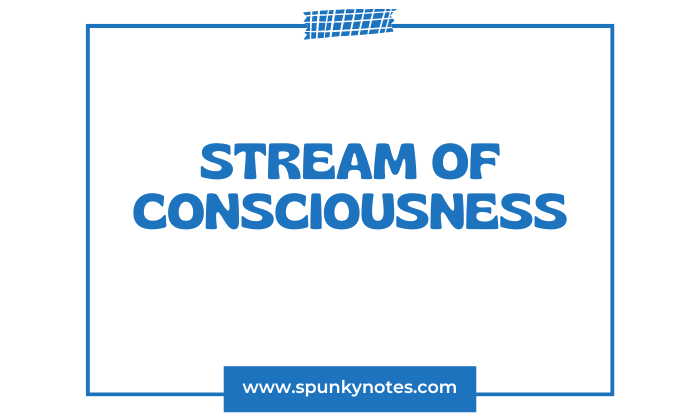

Updated on: June 8, 2024
Estimated Reading Time: 6 min

Estimated Reading Time: 6 min
Introduction
The stream of consciousness is a fascinating literary technique that enables a panoramic view of characters’ unfiltered thoughts and emotions. It emulates the human mind’s seemingly infinite and complex workings.
Through this powerful narrative tool, authors artfully weave a tapestry of raw, undiluted human experience that is often chaotic, non-linear, and deeply personal.
It surpasses traditional storytelling norms by shedding light on the intricate contours of consciousness and presents a comprehensive and vivid panorama of the human psyche.
Literary conventions of the bygone Victorian era started to crumble, creating new, innovative movements like Modernism that aimed to redefine the norms and explore fresh horizons.
Who coined the term stream of consciousness?
The esteemed psychologist William James coined the term’ stream of consciousness in his work “The Principles of Psychology” (1890).
He envisaged consciousness not as a stagnant pond but as a constantly flowing river, forever in motion and never at rest. In his view, consciousness is a dense, interconnected weave of thoughts, emotions, and memories. All contribute to the constitution of the human experience.
The Pioneers of Stream of Consciousness
The development and wide acceptance of the stream-of-consciousness technique can be attributed to three stalwarts of literature: James Joyce, Virginia Woolf, and William Faulkner.
Their works have significantly contributed to shaping our comprehension of the stream of consciousness in literature.
1- James Joyce
The Irish literary genius employed this technique to push the boundaries of narrative perspectives. His magnum opus, “Ulysses,” vividly depicts the characters’ mental landscapes during an ordinary day.
Joyce’s extensive use of long sentences and frequent shifts in perspectives portray the human mind’s capricious and complex nature, demonstrating how our thoughts seamlessly drift from one idea to another.
2- Virginia Woolf
Virginia Woolf is renowned for her pioneering use of the stream of consciousness technique in literature. In “Mrs Dalloway,” “To the Lighthouse,” and “The Waves,” Woolf masterfully used this technique. Her words became conduits, granting readers an extraordinary and intimate vantage point into the mindscape of her creations.
Woolf dismantled the confines of traditional storytelling. She also invited the reader to journey through the labyrinthine corridors of human thought. Her artistry reverberated through the ages, shaping the course of modernist and postmodernist movements.
This narrative technique provided a direct glimpse into the consciousness of her characters, revolutionizing the way writers portrayed the intricacies of human thought and perception.
3- William Faulkner
Faulkner harnessed the stream-of-consciousness technique to create intricate narratives. His novel “The Sound and The Fury” is marked by multiple narrators, each offering a unique, disjointed perspective.
His narrative captures the subjectivity and diversity of human experiences, reflecting how different individuals perceive and interpret the same events.
Understanding the Stream of Consciousness
With its unconventional narrative structures, the stream-of-consciousness technique presents a uniquely immersive and challenging reading experience. It requires readers to combine fragmented thoughts, impressions, and memories to form a coherent narrative.
Definition of Stream of Consciousness
The stream of consciousness is a narrative technique used in literature and psychology that attempts to depict the flow of a character’s thoughts, feelings, and perceptions in an uninterrupted and unfiltered manner. It is also the interconnected train of thoughts within the mind.
It aims to present the inner workings of the character’s mind, often in a spontaneous and non-linear fashion, without the traditional structure of organized paragraphs or chronological order.
Characteristics of Stream of Consciousness
Internal Monologues and Soliloquies offer a direct line into a character’s thoughts and emotions. They often express internal conflicts, memories, or sensory experiences, typically presented in a disjointed and non-linear fashion.
Free Association mirrors the natural workings of our mind, connecting one thought or memory to another based on associations rather than a logical or chronological progression of ideas.
Unconventional Use of Punctuation and Grammar is used by many authors. This technique adopts unconventional syntax and punctuation to represent the unbroken flow of consciousness. This includes long, run-on sentences, minimal use of quotation marks for dialogues, or inconsistent use of tense and person.
Reshaping Literary Narratives
This technique has not only influenced literature but has also left its mark on other forms of art, such as film and music. Artists from these domains have sought to represent human consciousness’s subjective, layered, and complex nature, inspired by the principles of stream of consciousness.
Despite the inherent challenges posed by this technique, it continues to enjoy popularity among writers. Contemporary authors have been adapting and innovating this technique to explore the intricacies of human consciousness. It invites the readers to journey into the unexplored territories of the mind.
The Everlasting Stream of Consciousness
The stream of consciousness in literature is a captivating and transformative journey that delves into the heart of the human mind. It surpasses being a mere literary device; instead, it becomes a gateway to understanding human consciousness’s intricate and boundless nature.
Through storytelling, a unique narrative technique unfolds, inviting readers into the unfiltered and genuine stream of a character’s thoughts. But as we venture through this uncharted train of thoughts and emotions, profound insights await us. It reveals the essence of these characters’ existence.
Notable Writers Who Used Stream of Consciousness
Some of the most notable writers who used the stream-of-consciousness technique included:
1- Marcel Proust
“In Search of Lost Time”, Marcel Proust utilized the mesmerizing stream-of-consciousness technique. Proust also skillfully navigated the intricate labyrinths of his characters’ inner worlds. His long and intricately woven sentences beautifully painted the landscape of human consciousness.
It captures the essence of thought and emotion with remarkable clarity. Through this remarkable exploration, Proust gifted the world with a timeless literary treasure that continues to resonate with readers across generations.
2- Samuel Beckett
Beckett presents a rather sad and often nonsensical perspective on human consciousness through his works like “Molloy” and “The Unnamable.”
His unique stream-of-consciousness approach blurs the lines between what is merely thought and what is spoken aloud. It beautifully mirrors the intricate and disjointed workings of the human mind. In this portrayal, he captures the chaos and fragmented nature within us all, profoundly exploring the human experience.
3- Dorothy Richardson
This British author is often credited with pioneering the stream-of-consciousness technique in her series of novels, “Pilgrimage”. Richardson’s extensive work deeply explored her protagonist’s inner life and perceptions.


